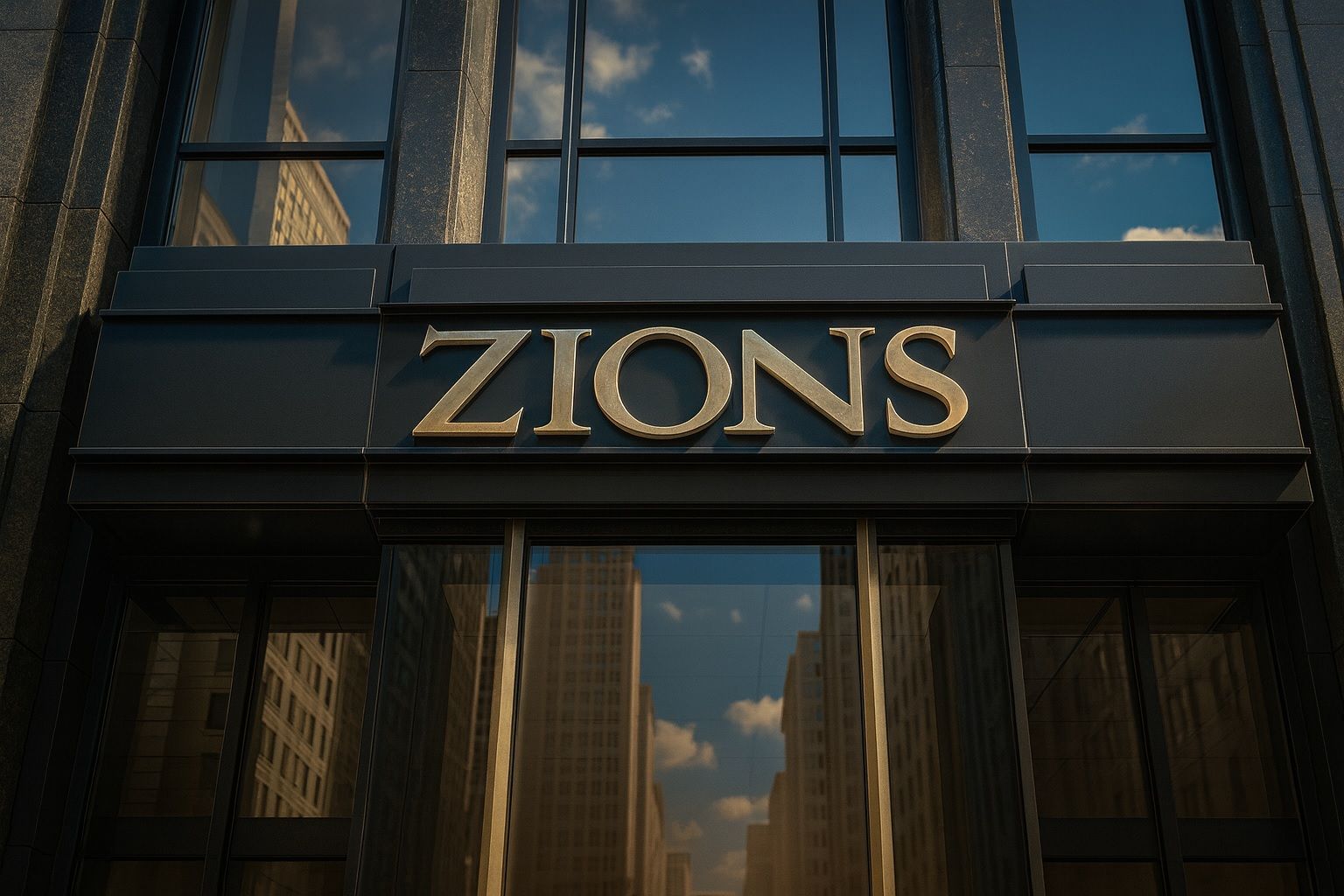- Surprise Loan Loss Hits Shares: Zions Bancorporation (NASDAQ: ZION) stunned investors by disclosing a $50 million loan loss linked to alleged fraud, sending its stock tumbling ~13% into the high-$40s per share [1]. The Utah-based regional lender uncovered “misrepresentations and irregularities” in two related loans totaling $60 million, prompting a swift $50 million charge-off and a lawsuit to recover funds [2].
- Regional Bank Jitters Spread:ZION’s plunge – its worst one-day drop in six months – ignited a broader selloff in U.S. bank stocks [3]. Western Alliance (WAL), a peer with tangential exposure to the same borrowers, fell ~11% [4], and the KBW Regional Banking Index sank ~5–6% on Oct. 16 [5]. Even banks with no direct connection sold off as investors grew uneasy about hidden credit stress in the high-rate environment [6].
- Earnings to Reveal Damage: Zions reports Q3 earnings on Oct. 20, offering management a chance to explain the fiasco. Analysts expect ~$1.45 EPS this quarter (up ~6% YoY) on $840 million revenue [7], but the $50M provision could shave roughly $0.30 off earnings [8]. Executives insist the fraud loss is “an isolated situation” and have hired outside investigators, yet Wall Street says Zions must prove this is truly one-off and not a symptom of wider risk-control issues [9].
- Analysts Cautious but See Upside:Wall Street’s consensus on ZION is Hold, reflecting uncertainty amid rising loan risks [10]. Price targets average ~$61 – ~25% above current levels [11] – suggesting significant upside if fears subside. After the selloff, ZION trades at just ~9× forward earnings with a 3.4% dividend yield [12], an attractive valuation if the bank’s fundamentals stay sound.
- Fragile Sentiment in Banking:Investor confidence in regional banks remains shaky. A string of recent “one-off” credit surprises – from Zions’ fraud loan to other bankruptcies – has traders “selling first and asking questions later,” a Truist analyst noted [13]. Experts are split: some argue these incidents are idiosyncratic and “don’t always lead to something systemic,” urging perspective [14], while others warn that multiple surprises can signal deeper issues, keeping the sector on edge [15].
Fraud Bombshell Sends Zions Stock Reeling
Zions Bancorp, a Salt Lake City-based regional bank, dropped a stunning disclosure this week: it found evidence of potential fraud in two large commercial loans worth about $60 million [16]. The borrowers – reportedly affiliated with an independent investment fund – allegedly misrepresented collateral and other information, prompting Zions to accelerate the loans to default and sue the guarantors in California [17]. The bank wrote off $50 million of the exposure and set aside reserves for the rest, effectively recognizing a full $60 million hit [18]. This charge-off will flow through Zions’ upcoming earnings, immediately denting Q3 profit.
The revelation alarmed investors. “The optics of a large C&I loan to a fraudulent borrower from a bank that specializes in small C&I loans is not great,” wrote Raymond James analysts, saying the surprise “raises questions” about Zions’ risk management and underwriting [19]. Zions’ bread-and-butter is lending to small and mid-sized businesses across the Western U.S., so a $60 million loan to an obscure investment fund was far outside its usual profile [20]. That may explain how this slipped through: the borrowers had already drawn legal scrutiny elsewhere, and Zions only caught wind of possible fraud when other lenders sounded alarms [21]. In short, it was a rogue lending bet gone bad, and management insists it’s an isolated case – “the Bank believes this is an isolated situation,” Zions said, noting it hired outside counsel for an independent review [22].
Markets were unforgiving. ZION stock opened sharply lower the next morning and kept sliding, ultimately closing down roughly 13% on Thursday [23]. That one-day plunge wiped out an estimated $600–700 million in market value, knocking shares to around the upper-$40s – multi-month lows [24]. The steep drop reflected both the direct hit to earnings and a broader crisis of confidence: investors immediately wondered “what else could be lurking” on bank balance sheets if a supposedly one-off fraud went undetected [25]. As Reuters put it, “hidden credit stress” has become a major concern with the economy under strain and interest rates still relatively high [26] [27]. In other words, if one mid-size bank got blindsided by a bad loan, could there be more surprises waiting at other lenders?
Sector-Wide Jitters and Market Fallout
Zions’ fraud fiasco reverberated across the banking sector. Upon the news, regional bank stocks plunged in sympathy [28] [29]. Western Alliance (WAL), another prominent regional lender, saw its shares nosedive ~11% on the same day [30]. Notably, Western Alliance wasn’t directly involved in Zions’ loans – but it acknowledged it had a lending relationship with a related borrower and had already filed its own fraud lawsuit back in August [31]. (Western Alliance says it has sufficient collateral and even reaffirmed its 2025 guidance to calm investors [32].) The mere hint that another respected regional bank was tangentially caught up in a fraud scenario was enough to rattle confidence across the sector [33].
Beyond those two, any bank perceived as exposed to risky loans got punished. The KBW Regional Banking Index (KRX) – a broad gauge of mid-sized bank stocks – plunged around 5–6% on Oct. 16 [34]. Even banks with no obvious connection to Zions sold off, illustrating how fragile sentiment remains. For example, Jefferies Financial Group (JEF), an investment bank that had exposure to the recent First Brands auto-parts bankruptcy, saw its stock drop ~10% on fears of “what’s next” in credit surprises [35]. In total, an estimated $100 billion in U.S. bank market value was wiped out in the selloff [36], as jittery investors flocked out of financials.
This turmoil hit a market that was just starting to regain optimism. Earlier in the week, big Wall Street banks like JPMorgan and Wells Fargo had reported strong Q3 results, sparking a brief rally in bank stocks (ZION itself jumped ~3.5% on Oct. 14) [37]. Major banks boasted robust trading revenue and solid net interest income, and even Fed Chair Jerome Powell hinted at easing back on tightening, all of which had lifted hopes that the banking sector was on solid footing [38]. But Zions’ surprise disclosure abruptly shattered that calm – a stark reminder that an idiosyncratic blow-up can swiftly sour the mood. “When you see one cockroach, there are probably more,” JPMorgan CEO Jamie Dimon warned recently [39]. Zions’ $50 million fraud loss became exactly that “cockroach” investors feared – a signal that perhaps deeper infestations lurk in the credit markets [40].
Importantly, the ripple effects weren’t confined to U.S. markets. Signs of U.S. credit stress put global investors on alert. Japan’s Nikkei and Hong Kong’s Hang Seng both fell ~1.5–2% the next day, and European bank stocks slid nearly 3% [41]. In a flight to safety, gold prices spiked to record highs above $4,300/oz [42] and U.S. Treasury yields plunged to year-to-date lows (the 10-year fell under 4%) as traders bet the Federal Reserve will cut rates if turmoil spreads [43]. Ironically, those falling yields and rising rate-cut bets could eventually help banks – easing funding costs and lifting bond values – but the immediate reaction was pure fear. “With the added uncertainty of U.S.-China trade and increased rhetoric … that’s adding to market instability,” one wealth strategist noted, reflecting how multiple risk factors (credit, rates, geopolitics) are now swirling together [44].
Analysts: One-Off Problem or Tip of the Iceberg?
Is Zions’ debacle a contained one-off or a red flag for broader issues? This is the question on every analyst’s mind. Zions’ management insists the fraud loss is a singular event – they’ve repeatedly characterized it as “isolated” [45]. The bank proactively launched an internal investigation as soon as it learned other lenders had raised red flags about the borrowers, and it brought in outside counsel to double-check its findings [46]. In other words, Zions is signaling: we got duped by a bad actor, but we’re addressing it and no other loans are affected.
Still, Wall Street is not taking that on faith. “Zions faces the challenge of showing that this is a one-off event and not indicative of broader…credit control weakness,” cautioned Brian Mulberry of Zacks Investment Management [47]. Analysts say the onus is now on Zions to prove its underwriting and oversight are solid apart from this aberration [48]. That means in coming quarters, management will be under the microscope to demonstrate no similar time-bombs are lurking in its $90 billion loan portfolio.
Some experts are inclined to give Zions the benefit of the doubt – for now. “Bankruptcies and fraud are natural in markets, but it doesn’t always lead to something systemic,” noted David Wagner, head of equities at Aptus Capital, urging perspective [49]. In this view, Zions’ blow-up might just be an idiosyncratic, borrower-specific failure. Analysts at KBW echoed that sentiment, pointing out that after high-profile collapses like subprime lender Tricolor and auto-parts maker First Brands earlier this fall, “investors are rightfully on high alert for any change in asset quality trends,” yet so far these incidents “seem tied to individual problem borrowers” rather than a broad meltdown [50]. In Zions’ case, the problematic loans were to a niche investment fund, not to any well-known company, which suggests the issue could be contained [51]. Stephens bank analyst Terry McEvoy underscored that Zions’ bad loans “are not connected to the recent bankruptcy announcements” in the sector, reinforcing that this was a separate rogue event [52].
However, many are not so sanguine. Even isolated credit events can erode trust, especially coming after a string of “one-offs” at various banks. “There have been enough ‘one-offs’ in commercial credits for banks of late that investors are selling first and asking questions later,” wrote Truist analyst David Smith [53]. Indeed, Zions is hardly alone in springing a nasty surprise – over the past year, numerous regionals have disclosed unexpected write-downs (from office real estate losses to fraud-related charges). Each incident on its own might be unique, but together they feed a narrative that bank balance sheets could be hiding more mines [54]. “It shows you can’t take credit quality for granted, and poor performing credit at one bank can drag down the group quite fast,” warned Stephen Biggar, banking analyst at Argus Research [55]. This pattern has put investors on hair-trigger alert. Confidence is fragile, and as JPMorgan’s Dimon hinted with his cockroach analogy, the market will assume the worst – that more problems remain unseen – until banks prove otherwise [56].
Another concern is why Zions was blindsided now, when peers already flagged similar issues. Truist’s Smith noted that other banks disclosed loan losses tied to recent big bankruptcies (like First Brands and Tricolor) weeks ago, whereas Zions’ issue surfaced later with little warning [57]. That lag raised eyebrows: did Zions miss earlier red flags, or is this fraud loss truly unrelated to those headline cases? Zions insists the troubled loans were to an “independent investment fund” with no direct link to First Brands or Tricolor [58]. But the timing – coming on the heels of those collapses – fueled speculation that something was missed in Zions’ risk controls [59]. This will likely be a key question on the earnings call.
Earnings Outlook and Stock Forecast
All eyes now turn to Zions’ third-quarter earnings report on Monday, Oct. 20. That will be management’s first detailed commentary since this debacle, and it could make or break the stock’s near-term trajectory. Analysts still expect Zions to post a profit for Q3 – consensus EPS was around $1.45 (up about 6% year-over-year) on ~$840 million revenue before the fraud charge [60]. The $50–60 million provision will cut into that, roughly shrinking earnings by ~$0.30 per share after taxes [61]. That means Zions might miss earlier profit forecasts, though it should remain in the black for the quarter. Beyond the numbers, investors will scrutinize management’s tone and transparency. They’ll want reassurance that this was a one-time lapse, details on how these loans slipped through, and what’s being done to tighten oversight. If CEO Harris Simmons and his team can convincingly outline why this won’t happen again, it could go a long way to rebuilding confidence.
On the flip side, any hesitance, lack of detail, or hints of other issues could prolong the pain. “If further disclosures reveal more losses or related exposures, the risk is that the broader regional banking index – or weaker names – gets re-rated aggressively downward,” warned Zacks’ Mulberry [62]. In plain English: another nasty surprise from Zions or its peers could trigger a wider selloff. Given how skittish the market is, Zions likely needs to over-communicate on Oct. 20 to shore up trust.
Looking beyond this quarter, Wall Street’s outlook on ZION is cautious but not bearish. As noted, the average 12-month price target sits around $61–62 [63] [64]. Even after trimming estimates post-fraud, Piper Sandler analysts set a target of $59 [65], which is ~20% above the recent ~$49 share price. In late September – before this incident – several analysts had actually raised their targets into the mid-$60s, citing improving net interest margins and efficiency gains at Zions [66]. The stock’s plunge has made its valuation look tempting: ZION now trades at only ~9× forward earnings and yields ~3.4% in dividends after a recent hike [67]. In other words, a lot of bad news is arguably baked into the price. If the bank can deliver steady results and avoid new mishaps, the stock has room to rebound. By some estimates, simply returning to the average target would be a ~25% gain from here.
That said, few are pounding the table to buy aggressively just yet. The consensus recommendation is essentially Hold [68]. Of about two dozen analysts covering Zions, most are on the fence – reflecting the uncertain economic and regulatory backdrop for banks [69]. Unlike the biggest banks (some of which are rated Strong Buys), Zions sits in a middle ground: bulls see an undervalued franchise with a solid deposit base across 11 Western states, while bears see a regional lender still facing interest-rate and credit headwinds [70]. Indeed, the macro environment is a double-edged sword. Higher interest rates over the past year have boosted banks’ net interest income (earning more on loans), but they also pressure borrowers and have raised recession risks. Funding costs for regionals have increased as customers seek higher yields, squeezing margins for some. Encouragingly, there are signs the tide could be turning: long-term Treasury yields fell below 4% this week to their lowest level of 2025 [71], amid growing expectations that the Fed might cut rates in coming months if economic growth falters [72]. Lower rates would ease banks’ deposit costs and could revive loan demand. However, rate cuts usually accompany weaker economic conditions – a trade-off not all investors would welcome.
Meanwhile, big-bank commentary suggests this isn’t 2008. Aside from JPMorgan’s proactive “cockroach” precautions, the largest U.S. banks actually set aside very modest loan-loss reserves in Q3 – collectively the lowest in two years [73]. That indicates they aren’t bracing for a credit apocalypse, seeing recent issues as manageable. If the economic landing stays soft, regional banks like Zions could ride it out with only isolated bruises. As one strategist noted, “the bull market remains intact” despite these scares, and some contrarians view the current dip in bank stocks as a buying opportunity [74]. For instance, ZION is still up about +55% over five years (even after this drop), underscoring that long-term investors who stomach the volatility have been rewarded [75].
Bottom Line
Zions Bancorp’s near-term fate hangs on two things: fixing its misstep and navigating a tricky landscape. The bank’s top priority is to restore trust – convincing the market that this $50 million fraud loss was a one-off blunder, not a sign of deeper trouble. Equally important, Zions must continue delivering solid core performance: stable net interest income, controlled expenses, healthy capital ratios. If management can pull off both – repair confidence and maintain fundamentals – there is meaningful upside for the stock, given how far it has fallen. ZION is still down ~10% year-to-date [76] and over 20% below its late-2024 peak around $62 [77], underperforming the broader market. That slump partly reflects broader regional bank woes, but also this latest stumble.
Investor sentiment, however, won’t rebound overnight. Memories of the Spring 2023 regional bank scare (when several banks failed) remain fresh, and any whiff of trouble makes traders jumpy. “You don’t ignore anything that might be a yellow flag in the credit markets,” cautions one veteran chief investment officer [78]. Zions’ job now is to contain the damage from this incident. All eyes will be on its Oct. 20 earnings call for frank answers and evidence of tighter controls. If no new “cockroaches” emerge and management addresses concerns head-on, ZION stock could stabilize and even grind higher in the coming weeks. But until the bank proves this truly was an isolated blip, investors are likely to remain on edge – ready to sell at the first hint of another surprise [79] [80]. In the cautious words of Zacks’ Mulberry, Zions “faces the challenge” of demonstrating that it has learned from this setback and that its house is otherwise in order [81]. The stakes are high next week: Zions will either turn the page on this chapter – or find the market unforgiving if any doubt lingers.
Sources: Zions Bancorporation SEC 8-K filing (Oct. 15, 2025); Reuters [82] [83] [84]; TS² Tech [85] [86] [87]; Investing.com [88]; GuruFocus; MarketBeat.
References
1. ts2.tech, 2. ts2.tech, 3. ts2.tech, 4. ts2.tech, 5. ts2.tech, 6. www.reuters.com, 7. ts2.tech, 8. ts2.tech, 9. ts2.tech, 10. ts2.tech, 11. ts2.tech, 12. ts2.tech, 13. ts2.tech, 14. ts2.tech, 15. ts2.tech, 16. ts2.tech, 17. ts2.tech, 18. ts2.tech, 19. ts2.tech, 20. ts2.tech, 21. ts2.tech, 22. ts2.tech, 23. ts2.tech, 24. ts2.tech, 25. ts2.tech, 26. ts2.tech, 27. www.reuters.com, 28. ts2.tech, 29. ts2.tech, 30. ts2.tech, 31. ts2.tech, 32. ts2.tech, 33. ts2.tech, 34. ts2.tech, 35. ts2.tech, 36. ts2.tech, 37. ts2.tech, 38. ts2.tech, 39. ts2.tech, 40. ts2.tech, 41. ts2.tech, 42. ts2.tech, 43. ts2.tech, 44. www.reuters.com, 45. ts2.tech, 46. ts2.tech, 47. ts2.tech, 48. ts2.tech, 49. ts2.tech, 50. ts2.tech, 51. ts2.tech, 52. ts2.tech, 53. ts2.tech, 54. ts2.tech, 55. www.reuters.com, 56. ts2.tech, 57. ts2.tech, 58. ts2.tech, 59. ts2.tech, 60. ts2.tech, 61. ts2.tech, 62. ts2.tech, 63. ts2.tech, 64. ts2.tech, 65. ts2.tech, 66. ts2.tech, 67. ts2.tech, 68. ts2.tech, 69. ts2.tech, 70. ts2.tech, 71. ts2.tech, 72. ts2.tech, 73. ts2.tech, 74. ts2.tech, 75. ts2.tech, 76. ts2.tech, 77. ts2.tech, 78. www.reuters.com, 79. ts2.tech, 80. ts2.tech, 81. ts2.tech, 82. www.reuters.com, 83. www.reuters.com, 84. www.reuters.com, 85. ts2.tech, 86. ts2.tech, 87. ts2.tech, 88. www.reuters.com







